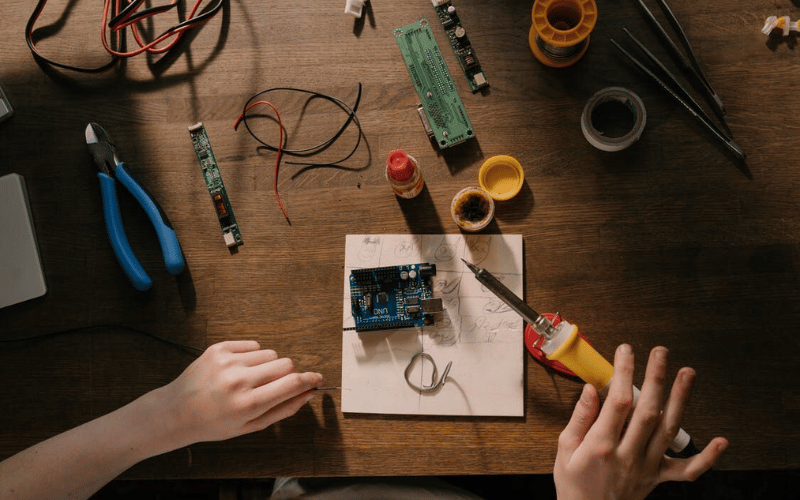Soldering Equipment Inspection: A Comprehensive Guide

Introduction
Welcome to our comprehensive guide on the inspection and testing of soldering equipment. In this article, we will delve into the critical processes and procedures required for ensuring the safety, reliability, and optimal performance of soldering equipment. Whether you are a hobbyist or a professional, this guide will equip you with essential knowledge for maintaining your soldering equipment in top condition.
Chapter 1: Understanding Soldering Equipment Inspection
1.1 What is Soldering Equipment Inspection?
Soldering equipment inspection is a critical process that ensures the safety, quality, and efficiency of soldering irons, stations, and other related accessories. It involves a comprehensive evaluation of the equipment to identify wear, damage, and functional issues.
- Visual Examination: This involves visually inspecting the soldering equipment for any signs of wear, discoloration, or physical damage.
- Electrical Testing: Testing the electrical components of the equipment to ensure proper functionality and safety.
- Temperature Calibration: Calibrating the temperature settings of soldering stations to ensure accurate and consistent heat levels.
- Functional Testing: Testing the overall functionality of the equipment to ensure it performs as intended.
Proper inspection of soldering equipment is crucial for several reasons:
- Ensures user safety by identifying potential hazards and malfunctions.
- Enhances product quality and reliability by maintaining properly functioning equipment.
- Optimizes performance and efficiency of soldering processes.
1.2 Types of Soldering Equipment
When it comes to soldering, having the right equipment is crucial. There are several types of soldering equipment, each serving specific soldering needs. Let’s take a closer look at the various types:
- Soldering Irons: These are the most common type of soldering equipment. They come in different wattages and tip sizes, allowing for versatility in soldering various components. Some soldering irons have adjustable temperature settings to accommodate different melting points of solder.
- Soldering Stations: Also known as soldering systems, these offer more advanced features compared to soldering irons. They often include a base unit with a digital display for precise temperature control, interchangeable tips, and built-in safety features such as automatic shutoff.
- Desoldering Tools: These tools are essential for removing soldered components or correcting soldering mistakes. Desoldering pumps, wicks, and solder suckers are commonly used tools for this purpose.
- Soldering Accessories: A variety of accessories complement the soldering process, including solder wire, solder flux, soldering stands, soldering fume extractors, and heat-resistant mats. These accessories contribute to the efficiency and safety of the soldering task.
Each type of soldering equipment has unique features and functions tailored to different soldering applications and requirements. By understanding the differences and capabilities of these tools, soldering tasks can be executed with precision and ease.
1.3 Common Soldering Defects and Failures
When it comes to soldering, various defects and failures can arise, impacting the overall quality and reliability of soldered joints. Identifying and addressing these issues is crucial for ensuring the effectiveness of the soldering process. Let’s explore some of the common soldering defects and failures:
- Cold Solder Joints: These occur when the soldering process does not create a sufficiently strong bond between the components, leading to poor electrical conductivity and mechanical strength.
- Solder Bridging: In this defect, excess solder forms a bridge between two conductive elements, potentially causing short circuits and electrical malfunctions.
- Insufficient Wetting: When the solder does not adequately cover the surface of the metal components, it results in poor adhesion and compromised joint integrity.
- Thermal Damage: Excessive heat during the soldering process can lead to thermal damage, affecting the properties of the solder and the components being joined.
These defects and failures can be mitigated through thorough inspection, testing, and adherence to best practices in soldering techniques. By understanding these common issues, professionals can take proactive measures to enhance the quality and reliability of soldered connections.
Chapter 2: Inspection and Testing Procedures
2.1 Pre-Inspection Preparation
Prior to conducting soldering equipment inspection, thorough pre-inspection preparation is essential. This involves ensuring a well-lit and well-ventilated workspace, gathering necessary inspection tools, and reviewing safety protocols. Adequate preparation sets the stage for efficient and effective equipment inspection.
- Check the workspace for proper lighting and ventilation to ensure a safe and comfortable environment for inspection.
- Gather the necessary inspection tools, including magnifying glasses, soldering iron stands, and temperature probes.
- Review safety protocols and ensure that all necessary personal protective equipment (PPE) is available and in good condition.
- Verify the functionality of all inspection tools and ensure they are calibrated and accurate.
2.2 Visual Inspection Techniques
Visual inspection techniques play a crucial role in identifying visible defects and irregularities in soldering equipment. This includes examining solder joints, components, and soldering accessories for physical damage, corrosion, and signs of wear. Visual inspections provide valuable insight into the condition of the equipment.
- Direct Visual Inspection: This involves physically examining the soldering equipment and components for any visible defects, such as cracks, discoloration, or improper connections. It is a fundamental method for identifying visible defects.
- Magnified Visual Inspection: Using tools such as magnifying glasses or microscopes to closely examine solder joints and components for minute defects, such as hairline cracks, erosion, or foreign materials.
Visual inspection is critical in ensuring the reliability and functionality of soldering equipment. By uncovering defects and irregularities, visual inspections contribute to the overall quality control and maintenance of the equipment, ultimately leading to enhanced performance and safety.
2.3 Functional Testing Methods
Functional testing methods involve assessing the performance and functionality of soldering equipment through operational tests. This can include evaluating temperature settings, soldering quality, heat transfer, and overall equipment efficiency. Functional testing helps ensure that the equipment meets operational requirements.
- Temperature Settings Assessment: This involves evaluating the accuracy and consistency of temperature settings on the soldering equipment to ensure optimal performance and soldering quality.
- Soldering Quality Evaluation: The examination of soldering quality includes inspecting the integrity, strength, and uniformity of solder joints to guarantee reliable connections.
- Heat Transfer Analysis: Assessing the heat transfer capabilities of the equipment is crucial to verify efficient soldering and prevent thermal damage to components.
- Overall Equipment Efficiency Testing: The evaluation of the overall efficiency of the soldering equipment encompasses factors such as power consumption, time management, and resource utilization.
2.4 Advanced Testing Procedures
Advanced testing procedures encompass a range of specialized tests designed to provide comprehensive insights into the performance and reliability of soldering equipment. These procedures go beyond standard testing methods and focus on in-depth analysis and assessment.
- Thermal Profiling: This advanced testing method involves the detailed analysis of the thermal behavior of soldering equipment. By monitoring temperature profiles and heat distribution, it allows for the identification of potential issues related to overheating, component damage, or inadequate soldering.
- Solder Joint Analysis: This specialized test focuses on examining the integrity and quality of solder joints. It involves microscopic analysis of solder connections to assess their structural integrity, strength, and resistance to thermal stress.
- Reliability Testing: This crucial testing procedure involves subjecting soldering equipment to extended operational conditions to evaluate its long-term performance and durability. It involves accelerated aging tests, stress testing, and performance evaluations under various environmental conditions.
By incorporating these advanced testing procedures, manufacturers and technicians can gain valuable insights into the thermal behavior, solder joint integrity, and long-term performance of soldering equipment. These insights are essential for ensuring the reliability, quality, and safety of soldering processes.
Chapter 3: Maintaining Soldering Equipment
3.1 Cleaning and Maintenance Practices
Regular cleaning and maintenance practices are essential for preserving the performance and longevity of soldering equipment. This includes proper cleaning of soldering tips, inspection of heating elements, and adherence to manufacturer’s maintenance guidelines. Effective maintenance ensures the reliability and durability of the equipment.
- Use of appropriate cleaning tools and solvents
- Frequency of cleaning based on usage
- Inspection of soldering tips for signs of wear and oxidation
- Proper storage of equipment after use
- Regular calibration and testing of heating elements
3.2 Storage and Handling Guidelines
- Proper storage and handling of soldering equipment are essential for ensuring longevity and performance.
- Storage guidelines should be adhered to for soldering irons, tips, and accessories. This includes using designated storage areas or cases to prevent damage or misplacement.
- Humidity and temperature can significantly impact soldering equipment. Storing the equipment in controlled environments with appropriate ventilation can mitigate these effects.
When storing soldering equipment:
- Use a dry and secure storage area to prevent corrosion and damage.
- Securely store the soldering irons, tips, and accessories to prevent breakage or loss.
- Account for the heat and energy requirements of the equipment when considering storage solutions.
Handling guidelines:
- Handle soldering equipment with care to avoid physical damage or compromising their integrity.
- Use protective coverings for soldering irons and tips when not in use to prevent contamination and maintain their condition.
- Follow safety instructions when moving or transporting soldering equipment to prevent accidents and damage.
Conclusion
In conclusion, the inspection, testing, and maintenance of soldering equipment are essential for ensuring safety, reliability, and optimal performance. By implementing thorough inspection procedures, effective testing methods, and proper maintenance practices, individuals can uphold soldering standards and safeguard the quality of soldering projects. We hope this comprehensive guide equips you with valuable knowledge to maintain your soldering equipment in top condition, ultimately enhancing the quality and longevity of your soldering endeavors.
